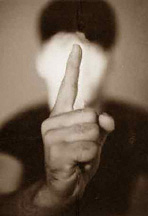- Home
- Archive -Sept 1998
- WIND BENEATH YO. . .

WIND BENEATH YOUR WINGS
- In :
- Personal Growth
September 1998
By Life Positive
Personal growth is the process of unfolding your full potential and achieving what you came to the earth for. Life Positive offers you some unique personal growth exercises from the world’s best teachers and systems
 |
‘We have made thee, Adam, neither mortal nor immortal, so that with freedom of choice and with honor, thou mayest fashion thyself in whatever shape thou shalt prefer…’
—Pico della Mirandola, Italian humanist, 15th century
‘All the evidence that we have indicates that in practically every human being there is an active will towards health, an impulse towards… the actualization of human potentialities…’
—Abraham Maslow, American psychologist, 20th century
From Pico to Maslow, and much before them, the recognition of Man’s immense potential, the spark of the divine in him, has remained a constant factor. And so has the bewilderment with humanity’s tendency to stop evolving or, worse, regressing. There have been exceptions like the Buddha or Christ. However, instead of learning the mantra of evolution from them, we have been content in idolizing them as gods or demigods.
It is not that we are unaware of the infinity and eternity within. As Maslow states: ‘We enjoy and even thrill to the godlike possibilities we see in ourselves in our most perfect moments, under conditions of greatest courage.’ But where does this thrill go once that moment is past?
Perhaps the solution lies in consciously striving for personal growth. Each area of your life that you are able to improve becomes a tributary that meets life’s stream, making it a roaring river that eventually merges in the ocean, call it God or Universe. Personal growth, you may like to say, is holistic growth, which is not different from spiritual growth.
Personal growth is by definition individual specific. Hence there is no place for panaceas and generalizations. Yet, this article suggests some widely applicable methods and techniques that you can try and benefit from. But keep in mind that only keen desire and persistent efforts pay dividends. You can gauge your growth when you see your Self reflected in everything you do.
The simplest, but not necessarily the easiest, technique is to be aware of everything you do during the day: even mundane acts like brushing your teeth or eating. This inevitably brings you to the present moment, the eternal moment, putting you in a meditative state.
You may as well ask: ‘I think my life is looking up fine. So, what’s there for me in this personal growth business?’ True. Tangible, material benefits may not be apparent, but they always follow. The least that can be said is that your life will start to flow seamlessly: whether it is relationships, mental health or work fronts. You will also be able to tap reserves of energy that you didn’t know existed, to accomplish whatever you want to accomplish.
RAISE ENERGY
All your activities are governed by the energy within the body. In most cases, listlessness, sloth and ill-health result from a decline in energy levels. According to Subhas Patri, a mystic based in the southern Indian temple town of Tirupati, people often overburden themselves by indulging in unnecessary activities. Following are some tips from Patri on various aspects of life that may help enhance your energy levels:
Communication
• Maintain ‘verbal’ silence as much as possible. Speak only when necessary.
• Speak briefly, to the point and in a simple and easily understandable language.
• Don’t go for style; give more credence to clarity.
Seeing
• Almost 80 percent of your energy is used up in the activity of seeing. Keep your eyes open only when the work you are doing requires sight or when you want to observe what is happening around you.
• When there is nothing important to see, keep your eyes closed and mentally begin observing your breath.
• While talking to somebody, look straight into the eyes of the other person.
Sleeping
• Observe your breathing pattern while going to sleep at night.
• Learn to sleep while sitting.
• Your daily sleep requirement should come in two or three doses in a day-night cycle. Try and take an afternoon siesta every day.
PSYCHOSYNTHESIS
An amalgamation of various psychotherapy doctrines, psychosynthesis has been considered a practical and viable method involving various personal growth techniques. Developed by psychologist Roberto Assagioli, it aims to ‘release or, let us say, help to release, the energies of the Self’. These are some psychosynthesis exercises for exalting Selfhood:
Training the Will
• Vividly visualize all the unfortunate incidents which have occurred in your life as a result of your inadequate will. Examine each incident carefully, formulating them clearly and then make a list of them. Allow yourself to be affected by the feelings, which these recollections arouse—shame, dissatisfaction with yourself, regret, and the desire to change.
• Visualize the advantages of a stronger will. Examine and formulate all the benefits and satisfactions and write them down. Allow yourself to feel the joy of these benefits, the intense desire to realize them and the strong impulse to begin at once.
• Finally, visualize yourself as being possessed of a strong and persistent will. See yourself walking with a firm step, acting in various situations with decision, concentration of effort, persistence and self-control. Visualize yourself successfully attaining the desired ends.
Evoking Serenity
• Assume a physical attitude of serenity. Relax all muscular and nervous tension. Breathe slowly and rhythmically. Express serenity on your face with a smile.
• Try to feel serene by repeating the word or some appropriate sentence.
• Imagine yourself in circumstances that would tend to agitate or irritate you; for instance, being in the midst of an excited crowd or confronting a hostile person. See and feel yourself calm and serene in such circumstances.
 |
PERFECT SENSES
Seek in the Dark
In your childhood, many of you must have played a game called ‘Dark Room’—hide-and-seek in the dark. This exercise is quite similar to that game, except that here you don’t have to hide, merely seek. Blindfold yourself in a dark room and try to locate various objects without having to feel around. Increase the degree of difficulty progressively, taking care against any physical harm. Seeing in the dark improves your level of visualization and concentration. It also makes you more alert and aware about your environment. Your capacity to observe more at a glance also increases.
Watch What You See
Start with this simple exercise: walk through a room and list in detail all that is there in the room. Progressively reduce the time spent walking through the room. Gradually, increase your field of observation to more and more complicated pictures and reduce the time spent in observing them—till you reach a point where you can see the full details of anything with your mind’s eye at a mere glance. Fast and comprehensive observation gives you a headstart when it comes to making split-second decisions. As a result, instead of reacting, you can take preemptive actions. This exercise improves your concentration.
Use The Other Hand
This exercise helps you utilize both the left and the right side of your brain. In the process, you acquire a balanced approach and a sharpened focus to life. Do it at least thrice a day, consciously, for 10 minutes. For right-handers, this would mean using the left hand and for left-handers the right. This exercise can be extended to even doing things differently, say reading a letter reflected off a mirror.
MAGICAL PASSES
Tensegrity—this is how best-selling author Carlos Castaneda describes the magical passes of the shamans of Mexico. Tensegrity is a mixture of two terms, tension and integrity. These exercises, according to Castaneda, lead to a redeployment of your energy in the body and a state of inner silence. This, in turn, creates a level of awareness where knowing is automatic and instantaneous. The following exercises have been taken from the book Magical Passes by Castaneda:
Foot Circles
Put your body’s weight on the right leg. Place your left foot half a step in front of it, and slide it on the floor, drawing a half circle to the left, so that the ball comes to rest almost touching your right heel. From there, draw another half circle to the back. Reverse the movement, from back to front.
 |
Scarecrow In The Wind
Extend your arms laterally at shoulder level with elbows bent and forearms dangling downward. Let your forearms swing freely from side to side.
Push Energy Backward
Bend your elbows and hold the forearms tightly against the sides of your body. Extend the forearm downward and backward as high as possible. Bend slightly forward and exhale. As you inhale, bring arms back to the sides. Now reverse the movement.
Pivot the Forearm
Hold your arms in front of the body, with elbows bent and forearms vertical. Bend your hands, cupped to resemble the head of a bird, at the wrist towards your face. Now flip the wrists back and forth, pivoting on the forearms.
Move Energy in Ripples
Keeping your knees straight, stoop down, with arms dangling by your side. Move the left arm forward with three ripples of the hand. Then cut across the front of your body with the same hand, first left to right and then reverse. Then move the hand back with three more ripples.
SACRED PSYCHOLOGY
Developed by personal growth trainer Jean Houston, sacred psychology “assumes that one’s fullest realization comes from the living experience of union with God, which is then expressed through the forms of daily life”. In other words, the work of sacred psychology is to school you in your own depths. A sample, taken from Houston’s The Search for the Beloved:
Extend Your Senses
Many people feel that nothing worth mentioning ever happens to them. This, Houston argues, is a misconception that arises from a dulled perception. On the other hand, people who feel more, listen more deeply, have a greater vision, find themselves living a life full of wondrous events. To enhance and extend the reach of your senses, Houston suggests an exercise to get in touch with your kinesthetic body, or the body image in your brain. The time taken for this exercise is 20 minutes.
• Stand up and get a sense of your body as it is, at rest, quiet, ready to experience.
• Raise your right arm over your head and feel the stretching of muscles throughout the arm and your torso. Lower your arm. Repeat this process several times, concentrating on the feeling of movement within you.
• Now sense your right arm as clearly as you can with your muscular imagination. Pause, and then stretch this kinesthetic right arm over your head. Try to experience it as vividly as you did the real arm. Lower your kinesthetic arm.
• Conduct the same exercise with your whole body, moving the real body on various sides and then doing the same with the kinesthetic body. The key is to feel the same sensations in your kinesthetic body as you feel in your real body. Movements can include jumping, lunging, or stretching your arms and legs.
TRANSFORM
Your personality is not what you are; it is something that you have. Through transformational exercises, you can dissociate from your personality and come closer to your true self. Here is an exercise from Jacquelyn Small’s Transformers: The Artists of Self-Creation:
• Stand quietly, closing your eyes for a while. Breathe deeply. Feel yourself relaxing and letting go.
• Spread your feet apart and feel your weight balancing between your legs. Bend your knees a little so that you can sway like a tree in a gentle wind.
• Become aware of your body and realize that it is a vessel of supreme beauty and bliss.
• Realize that your expression is the working of the gods. Be this Godself, this bliss, this joy.
• Now open your eyes and walk around in this newfound state of consciousness.
SUCCESS SUTRAS
Habits are probably the most influencing aspect of your life. In his best-selling book The Seven Habits of Highly Effective People, management guru Stephen R. Covey argues that since habit-formation is one of the most intense driving forces in anybody, the best recipe for personal growth and success should lie in forming positive habits. And the seven key habits for success, according to Covey, are:
 |
• Be proactive—Unlike reactive people, who are consistently affected by their physical or social environment, proactive people do not blame circumstances, conditions, or conditioning for their behavior. To become truly proactive, you should act and not wait to be acted upon.
• Begin with the end in mind—This habit is based on the principle that all things are created twice: once at the mental level and then at the physical level. Whenever you begin on a task, you should have the mental picture of the whole task.
• Put first things first—Once you have the end in mind, the next step is to begin the task. And this is where you utilize your decision and will power—in prioritizing your work, putting first things first.
• Think win-win—Win-win is a frame of mind and heart that constantly seeks mutual benefit in all human interactions. Here there is no wrangling over your way or my way: here, it is a question of the better way.
• Understand, then be understood: Try to understand what you hear and only then make yourself be understood. Don’t listen to reply, because while you are mentally preparing your reply, you might have missed out on the import of what you were hearing. In effect, you often land up misunderstanding people.
• Synergize: The whole is always greater than its parts. This is the core of synergy, the art of making one and one more than two.
• Sharpen the saw: Excessive work always depletes your energy. However, you must be aware of this depletion and not go on till the point when even your best efforts yield nothing. Always take some time out to replenish your energies—physical, spiritual, mental, social or emotional.
BEATITUDES
Attitudes are more important than facts. Success guru Robert H. Schuller says you need to replace your negative attitudes with positive ones for a happier, fuller life. Following are some of the Beatitudes he has discussed in his book The Be-Happy Attitudes:
• Ask for help when you need it: Admit to yourself that you are not perfect and are lacking something for which you need help. Admitting a need enables people to identify with you and boosts your self-esteem. In fact, confessions make you a more honest and likable person.
• Fix the problem: Grief and guilt sometimes go hand-in-hand. But self-condemnation does no good. First accept that no problem is tragic until your reaction makes it so. Think of what you have left instead of what you have lost. Think of the people who need your help and understanding and then of yourself.
• Don’t hold on to pain: We all have hidden wounds inflicted on us by society or prejudices or even those close to us. Don’t nurse or pamper them by continuously talking or thinking about them. Occupy yourself with some constructive work. You can reverse the effect by letting the pain make you a more sensitive and caring person.
DEEPENING INTIMACY
Whenever people share an intense experience together, such as a train accident or being stuck in a lift for hours, they feel a strong sense of bonding with each other.
The same effect can be created through meditation in close interactions. If you want a relationship to grow, it is imperative that you understand your partner. The following method, extracted from the book The Silva Mind Control Methodby Jose Silva and Philip Miele, is useful in this regard:
• Select a place where you both feel happiest and relaxed. It might be a place where you vacationed together or a place neither of you has visited. However, avoid places that only one of you has visited since individual memories can break the synchronicity of your experience.
• Sit comfortably, close, facing each other. Relax and close your eyes.
• Ask your spouse to say: “I’m going to count slowly from ten to one, and with each count you will find yourself going deeper into a pleasant, meditative state of mind. Ten, nine… two, one. You are now relaxed, at a deep, pleasant state of the mind. With your help, I will join you there.”
• You reply: “I will count slowly from ten to one, and with each count we’ll come closer in a deep level of mind. Ten, nine—feel that you are going deeper with me,… eight, seven… three—deeper still, two, one. We are now both relaxed. Let us go deeper together.”
• Your spouse will say: “All right, let’s go very deep together. The more we experience this, the deeper we will go. Notice the sky…”
• “Yes… it’s clear, with a few drifting clouds,” you will say. Then each of you will slowly, spontaneously, describe the scene you are experiencing together—the temperature, the color, the sounds, all the pleasant details.
• When you are both at a deep level and fully experiencing your place of relaxation, say to your spouse: “I want most in life to make you happy, and only then do I want to make myself happy.”
• Allow a period—as long as you want—of silent communion. Then wake up. You may experience this communion even more deeply by gazing into each other’s eyes. However, if keeping your eyes open disturbs your alpha state, don’t force it.
 |
SLOW DOWN
In the daily rat race, have you ever stopped in mid-stride and wondered what on earth are you running for? For someone addicted to a high-stress fast life, this may come as a surprise, but slowing down actuallyhelps. Following are some ways to retard your daily pace. These tips for a novel time management method are recommended by meditation teacher Eknath Easwaran in his book Take Your Time.
• Get up early: The pace you set first thing in the morning is likely to stay with you through the day. So, if you get up early and set an unfrenzied pace, you are less likely to get speeded up later on. Set aside half an hour every morning for meditation or inspired reading. Then have a leisurely breakfast with your family or friends before setting off for work.
• Ask “What is important?”: Make a list of your daily schedule. Cross out everything that is not necessary or beneficial. By doing this, you will find you have more time to do the things that are important for you. One of the most important outcomes of this kind of review is that it makes you admit to yourself that you can’t do everything.
• Don’t let yourself get hurried: Every one of us can benefit by planning our day and going through our tasks with concentration at a slow, even pace. When a situation arises that does require us to speed up, we should return as quickly as possible to our usual calm, thoughtful pace.
• Don’t crowd your day: Make wise choices about what you read during the day. And then take time to read carefully.
HIGHER GAMES
Happiness leaves nothing undone—such a simple statement but with such a lot of import! In order to popularize this maxim, New Age best-selling author Hugh Prather (better known for Notes to Myself) has formulated a host of uplifting mind-games. Following are samples from his book A Book of Games: A Course in Spiritual Play:
• Today, replace all names with only one. You may use a word that you already understand and love, or you may choose one from these: God, Love, Light, I, One, Peace. Do not neglect to include yourself in all you name as being one with you.
• Your planet recently established contact with planet Earth. You are about to make your first exchange visit there. The way the exchange is made is that two people, one on each planet, agree to leave their bodies right where they are and enter the other person’s body on its own planet. The exchange of inner selves takes only two seconds. And now you are blinking your eyes and looking around Earth for the first time. You know nothing about the past of the people around you. You are free to extend goodwill and look about at an entirely new world.
• The next time you find yourself fantasizing about the outcome of an unresolved situation, mentally list some of the ways you would ‘like’ for it to turn out. After you have done this, notice how many of them indicate opposing wishes. Does your ego really know what it wants?
 |
LUCID DREAMING
Drteams are rarely taken seriously, especially daydreaming. However, using a potent method of mental imagery, it is possible to direct your dreams consciously, and thus explore new worlds, dimensions, situations, and most importantly, yourself. In their book, Lucid Dreams in 30 Days: The Creative Sleep Program Keith Harary and Pamela Weintraub teach lucid dreaming in five days:
Day One: Altered States
Find a comfortable and private place to lie down. Take a deep breath, exhale slowly and relax. Now imagine that warm currents of mental energy are slowly moving up from the soles of your feet. Feel it going up, traversing through each part of your body, warming each muscle. Once you are relaxed, maintain this state for 30 minutes.
Day Two: Adventures of Gumby
Begin an hour before you go to sleep. Bring a television and a VCR into your room. Play a tape of animated cartoons, preferably surrealistic. The best choice would be Gumby or Ghostbusters. You can also use any cartoon channel for this purpose. Now turn off the light and keep the volume at a low yet audible level. Sit in a comfortable position and enjoy the show for 30 minutes. Absorb the characters. Close your eyes, repeat the relaxation technique of day one and concentrate on the sounds from the TV. Try to visualize the characters for 30 minutes. Then drift off to sleep.
Day Three: Winds of Change
Repeat the previous day’s procedure with a different program. Try to make the images spontaneous and follow them as they lead you into a lucid dream. Pay specific attention to the weather in the dream. Now try to change it. Notice how it affects your mood. Record all your dreams in a notebook.
Day Four: Shifting Sands
Do without the TV. Repeat the relaxation technique. Instead of concentrating on the cartoon, concentrate on the images that come spontaneously. Slowly, enter a lucid dream and again observe your surroundings. Now imagine a completely different surrounding. Observe changes and record the differences.
Day Five: Higher Consciousness
Choose a 30-minute period during the day. Contemplate on things that are unique to you. Just before you go to bed write these words on a piece of paper: “Let my deepest self find expression in my dreams.” Now turn off the light, relax and enter a lucid dream. Pay attention to your personality in the dream. Seek the symbolic meaning in each image. With practice, you will gain more understanding of the reality.
To read more such articles on personal growth, inspirations and positivity, subscribe to our digital magazine at subscribe here
Life Positive follows a stringent review publishing mechanism. Every review received undergoes -
- 1. A mobile number and email ID verification check
- 2. Analysis by our seeker happiness team to double check for authenticity
- 3. Cross-checking, if required, by speaking to the seeker posting the review
Only after we're satisfied about the authenticity of a review is it allowed to go live on our website
Our award winning customer care team is available from 9 a.m to 9 p.m everyday
The Life Positive seal of trust implies:-
-
Standards guarantee:
All our healers and therapists undergo training and/or certification from authorized bodies before becoming professionals. They have a minimum professional experience of one year
-
Genuineness guarantee:
All our healers and therapists are genuinely passionate about doing service. They do their very best to help seekers (patients) live better lives.
-
Payment security:
All payments made to our healers are secure up to the point wherein if any session is paid for, it will be honoured dutifully and delivered promptly
-
Anonymity guarantee:
Every seekers (patients) details will always remain 100% confidential and will never be disclosed
